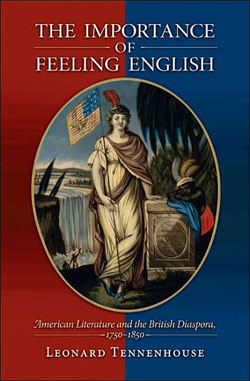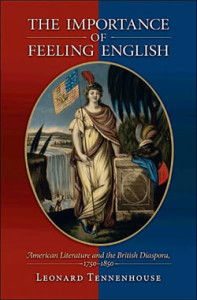Diasporic to Hegemonic

Insightful and lucid, Leonard Tennenhouse’s The Importance of Feeling English addresses the clean division of English and American literary traditions reflected in the structure of English departments at many American universities and perpetuated by the field’s major anthologies. Tennenhouse begins this project by asking an important question: when did anglophone literature begin to “divide internally into recognizable British and American traditions?” (1).
Looking for a model that “acknowledge[s] a perplexed but continuing relationship between nation-state and national culture,” Tennenhouse draws on what he calls a “culturalist view of diaspora” (3). Where the classic concept of diaspora maintains the connection between home and migrant community and expresses that community’s desire to eventually return home, Tennenhouse’s adoption of a “looser concept” of diaspora displaces the homeland—which, in the case of British North Americans after the Revolution, had “disappear[ed] as a geopolitical site to which the diasporic group can entertain the possibility of actually returning”—with a set of cultural practices that effectively reproduce the mother culture outside of the homeland (5). The Importance of Feeling English explores the fascinating reproducibility of English culture in North America; asks how it achieved hegemony over other diasporic cultures; and asks how, and under what conditions, its literary output became a national literature.
The focus throughout the book is largely on literary form—from captivity narratives to sentimental novels to gothic fiction—and the models of nation building each form presents in both its British and American incarnations. For example, Tennenhouse takes up the ideological divergence between the English and American versions of Samuel Richardson’s seduction novels and asks how the American Richardson addresses American interests. Americans dispensed with the British focus on letter writing and literary cultures. In the process, they shifted readers’ attention from heroines’ inner lives to their bodies. American-authored seduction stories, like the American redaction of Clarissa, Tennenhouse argues, “used the European libertine to think about the new nation as an aggregate of individuals capable of resolving differences of rank, status, and region through marriage,” through the exchange of women between households (71). Contrary to the captivity narrative, which typically insists on the captive daughter’s sexual purity and, therefore, “insists on preserving the group’s purity in the face of potential pollution” (119-20), these stories suggest that diasporic communities, replete with “fractured and makeshift families,” were not so much interested in the “loss of purity as [in] one’s fidelity to an idea of a home one imagined to be English” (63).
Americans reworked the gothic, just as they reworked the sentimental. Tennenhouse convincingly demonstrates how Americans replaced the Europeans’ signature convention—the castle or ruins—with a “secret history.” This plot device renders characters fundamentally unknowable to others (or to themselves) and inhibits them from forming an affective community. Where American sentimental novels imagined affective communities based on sympathetic identification, gothic fiction created communities based on contagion, coalesced by paranoia (115). Along these lines, Tennenhouse displaces Poe’s “Fall of the House of Usher” as the consummate American gothic tale in favor of Nathaniel Hawthorne’s “My Kinsman, Major Molineux.” Tennenhouse reads Hawthorne’s short story as a revision of Adam Smith’s widely read theory of moral sentiments and concludes, “According to Hawthorne, Smith’s model fails brilliantly in a community of dispersed individuals cut off from a place of origin and a collective history, because the coherence of such a community will depend on whom that group excludes rather than on how far it can extend its capacity for sympathetic identification” (115). In these terms, Tennenhouse views the gothic as a model for nation building that rethinks the terms of the originary community and patriarchal family in diaspora.
In a chapter that he claims will give us “a sense of what a literary history might look like were its goal to reveal how the two different national traditions developed in relation to each other rather than each in its own terms from different points of origin” (74), Tennenhouse traces the transatlantic origins of America’s unique brand of masculinity. To tell this story, he turns to the publication history of Charles Brockden Brown’s Clara Howard (1801). A reworking of Henry Mackenzie’s Man of Feeling (1771), Brown’s epistolary novel revised its European prototype’s depiction of the relationship between masculinity, sensibility, and literacy. Instead of fashioning a protagonist so burdened with sensibility that he is incapable of action and unable to acquire social position, Brown’s “man of feeling” is “empower[ed] … to act on behalf of ‘moral causes.'” Indeed, it is precisely this capacity for action, rather than his exalted prose, that enables him to marry a woman of superior birth and navigate a complicated social hierarchy (79). This idealized masculinity moved back and forth across the Atlantic: Tennenhouse reconstructs the publication history of Clara Howard to suggest that it prompted Jane Austen to transform her presentation of masculinity. The men who finally win the hands of Austen’s heroines “demonstrate that intense feelings unknown to the heroine lurk behind an exterior of paternal concern, extreme reserve, lukewarm affection, and even dislike” (85). Austen’s version of Brown’s “man of feeling”—the quintessentially American strong, silent type—then makes its way back across the Atlantic and into the fiction of James Fenimore Cooper. This compelling literary genealogy, which Tennenhouse traces through to Twain and Hemingway, suggests that American masculinity owed less to the frontier than to transatlantic exchange.
Perhaps the most valuable question this book raises is how English culture achieved hegemony over other diasporic cultures in North America and whether, as Tennenhouse puts it, it is “reasonable to call the English in America a ‘diasporic’ group,” given that the English (along with their American literature) become the basis of a new, more powerful nation (127). His answer is yes and no. On the one hand, the group that establishes the legal language and the terms of citizenship surely cannot be considered subordinate—the status usually associated with diaspora. On the other, as Tennenhouse argues throughout, in America, the English were but one transplanted group among many. They were in no way preordained to dominate the cultural field.
Despite Tennenhouse’s modest claims that “we stand to learn something new about American literature and its curious relation to English culture by thinking of it in terms of a diasporic literature,” his book helps revise the way we construct literary histories and challenges critics who attempt to locate something distinctly “American” in the literary output of the United States well before the 1850s (8). There is, obviously, much at stake in recognizing the diasporic relationships in North America. English departments at American universities and the leading anthologies in the field have been organized around a clean division of British and American literary traditions more or less coeval with America’s political independence. Tennenhouse urges us to look beyond the political schism of the Revolution toward a generic English culture that was reproduced and adapted in colonial North America and that ironically became even more English after the colonists won political independence.
This important book has implications for a far wider account of cultural exchange than Tennenhouse himself focuses on here. He uses a focused exploration of literary genealogy to ask questions about the development of American culture in the United States as a particular brand of Englishness. But there are limits to the kinds of things that literary history narrowly defined (the history of books and their publication in America and abroad) can tell us about culture more generally. Tennenhouse mentions the “rise in consumption of English goods” and the “re-Anglicization” of America after the Revolution but does not describe how these goods and processes influenced and functioned in the everyday lives of Americans (8). What else, for example, contributed to American masculinity and Cooper’s particular definition of manhood other than Jane Austen’s novels? Tennenhouse’s literary genealogies are compelling in their own right, but they cannot represent the totality of cultural development in the United States over the course of one hundred years, especially when we remember that the United States was a rapidly expanding nation that brought disparate diasporic cultures into contact with one another. In short, the transformation from diasporic to hegemonic was not accomplished by British Americans alone. The Importance of Feeling English encourages additional consideration about the relationships among diasporic cultures, including Spanish and African, in frontiers far away from the Northeast, which might be more sensitive to spatial and regional differences in an expanding United States.
This article originally appeared in issue 9.4 (July, 2009).
Spencer Snow is currently a Ph.D. candidate in English at the University of Illinois at Urbana-Champaign. His dissertation is entitled, “Reading the Map: The Nationalization of Geographic Space, Reading Publics, and the Shaping of Nineteenth-Century American Identity.”
